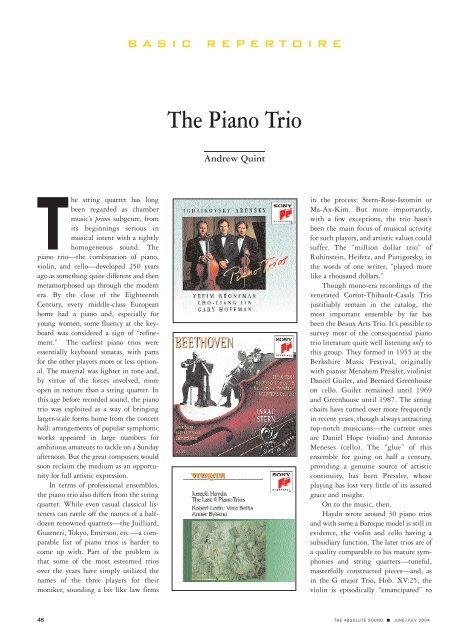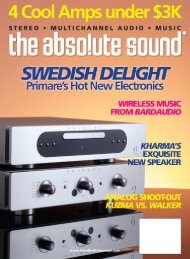Absolute Sound
Absolute Sound
Absolute Sound
Create successful ePaper yourself
Turn your PDF publications into a flip-book with our unique Google optimized e-Paper software.
The string quartet has long<br />
been regarded as chamber<br />
music’s primo subgenre, from<br />
its beginnings serious in<br />
musical intent with a tightly<br />
homogeneous sound. The<br />
piano trio—the combination of piano,<br />
violin, and cello—developed 250 years<br />
ago as something quite different and then<br />
metamorphosed up through the modern<br />
era. By the close of the Eighteenth<br />
Century, every middle-class European<br />
home had a piano and, especially for<br />
young women, some fluency at the keyboard<br />
was considered a sign of “refinement.”<br />
The earliest piano trios were<br />
essentially keyboard sonatas, with parts<br />
for the other players more or less optional.<br />
The material was lighter in tone and,<br />
by virtue of the forces involved, more<br />
open in texture than a string quartet. In<br />
this age before recorded sound, the piano<br />
trio was exploited as a way of bringing<br />
larger-scale forms home from the concert<br />
hall: arrangements of popular symphonic<br />
works appeared in large numbers for<br />
ambitious amateurs to tackle on a Sunday<br />
afternoon. But the great composers would<br />
soon reclaim the medium as an opportunity<br />
for full artistic expression.<br />
In terms of professional ensembles,<br />
the piano trio also differs from the string<br />
quartet. While even casual classical listeners<br />
can rattle off the names of a halfdozen<br />
renowned quartets—the Juilliard,<br />
Guarneri, Tokyo, Emerson, etc.—a comparable<br />
list of piano trios is harder to<br />
come up with. Part of the problem is<br />
that some of the most esteemed trios<br />
over the years have simply utilized the<br />
names of the three players for their<br />
moniker, sounding a bit like law firms<br />
BASIC REPERTOIRE<br />
The Piano Trio<br />
Andrew Quint<br />
in the process: Stern-Rose-Istomin or<br />
Ma-Ax-Kim. But more importantly,<br />
with a few exceptions, the trio hasn’t<br />
been the main focus of musical activity<br />
for such players, and artistic values could<br />
suffer. The “million dollar trio” of<br />
Rubinstein, Heifetz, and Piatigorsky, in<br />
the words of one writer, “played more<br />
like a thousand dollars.”<br />
Though mono-era recordings of the<br />
venerated Cortot-Thibault-Casals Trio<br />
justifiably remain in the catalog, the<br />
most important ensemble by far has<br />
been the Beaux Arts Trio. It’s possible to<br />
survey most of the consequential piano<br />
trio literature quite well listening only to<br />
this group. They formed in 1955 at the<br />
Berkshire Music Festival, originally<br />
with pianist Menahem Pressler, violinist<br />
Daniel Guilet, and Bernard Greenhouse<br />
on cello. Guilet remained until 1969<br />
and Greenhouse until 1987. The string<br />
chairs have turned over more frequently<br />
in recent years, though always attracting<br />
top-notch musicians—the current ones<br />
are Daniel Hope (violin) and Antonio<br />
Meneses (cello). The “glue” of this<br />
ensemble for going on half a century,<br />
providing a genuine source of artistic<br />
continuity, has been Pressler, whose<br />
playing has lost very little of its assured<br />
grace and insight.<br />
On to the music, then.<br />
Haydn wrote around 30 piano trios<br />
and with some a Baroque model is still in<br />
evidence, the violin and cello having a<br />
subsidiary function. The later trios are of<br />
a quality comparable to his mature symphonies<br />
and string quartets—tuneful,<br />
masterfully constructed pieces—and, as<br />
in the G major Trio, Hob. XV:25, the<br />
violin is episodically “emancipated” to<br />
48 THE ABSOLUTE SOUND ■ JUNE/JULY 2004










